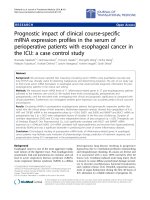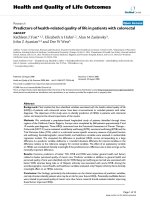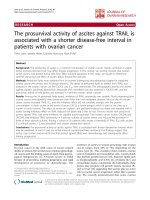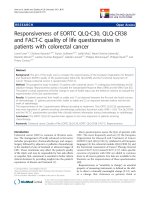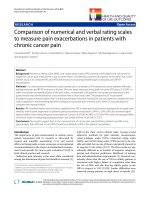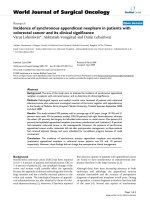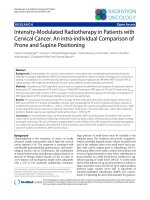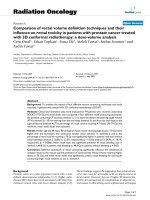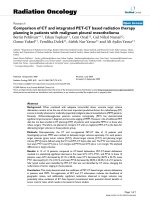The value of GRASP on DCE-MRI for assessing response to neoadjuvant chemotherapy in patients with esophageal cancer
Bạn đang xem bản rút gọn của tài liệu. Xem và tải ngay bản đầy đủ của tài liệu tại đây (670.98 KB, 9 trang )
Lu et al. BMC Cancer
(2019) 19:999
/>
RESEARCH ARTICLE
Open Access
The value of GRASP on DCE-MRI for
assessing response to neoadjuvant
chemotherapy in patients with esophageal
cancer
Yanan Lu1†, Ling Ma2†, Jianjun Qin3,4†, Zhaoqi Wang1, Jia Guo1, Yan Zhao1, Hongkai Zhang1, Xu Yan5, Hui Liu1,
Hailiang Li1, Ihab R. Kamel6 and Jinrong Qu1*
Abstract
Background: To compare the value of two dynamic contrast-enhanced Magnetic Resonance Images (DCE-MRI)
reconstruction approaches, namely golden-angle radial sparse parallel (GRASP) and view-sharing with golden-angle
radial profile (VS-GR) reconstruction, and evaluate their values in assessing response to neoadjuvant chemotherapy
(nCT) in patients with esophageal cancer (EC).
Methods: EC patients receiving nCT before surgery were enrolled prospectively. DCE-MRI scanning was performed
after nCT and within 1 week before surgery. Tumor Regression Grade (TRG) was used for chemotherapy response
evaluation, and patients were stratified into a responsive group (TRG1 + 2) and a non-responsive group (TRG3 + 4 +
5). Wilcoxon test was utilized for comparing GRASP and VS-GR reconstruction, Kruskal-Wallis and Mann-Whitney test
was performed for each parameter to assess response, and Spearman test was performed for analyzing correlation
between parameters and TRGs, as well as responder and non-responder. The receiver operating characteristic (ROC)
was utilized for each significant parameter to assess its accuracy between responders and non-responders.
Results: Among the 64 patients included in this cohort (52 male, 12 female; average age of 59.1 ± 7.9 years), 4
patients showed TRG1, 4 patients were TRG2, 7 patients were TRG3, 11 patients were TRG4, and 38 patients were
TRG5. They were stratified into 8 responders and 56 non-responders.
A total of 15 parameters were calculated from each tumor. With VS-GR, 10/15 parameters significantly correlated
with TRG and response groups. Of these, only AUCmax showed moderate correlation with TRG, 7 showed low
correlation and 2 showed negligible correlation with TRG. 8 showed low correlation and 2 showed negligible
correlation with response groups. With GRASP, 13/15 parameters significantly correlated with TRG and response
groups. Of these, 10 showed low correlation and 3 showed negligible correlation with TRG. 11 showed low
correlation and 2 showed negligible correlation with TRG. Seven parameters (AUC* > 0.70, P < 0.05) showed good
performance in response groups.
(Continued on next page)
* Correspondence:
†
Yanan Lu, Ling Ma and Jianjun Qin contributed equally to this work.
1
Department of Radiology, the Affiliated Cancer Hospital of Zhengzhou
University & Henan Cancer Hospital, 127 Dongming Road, Zhengzhou
450008, Henan, China
Full list of author information is available at the end of the article
© The Author(s). 2019 Open Access This article is distributed under the terms of the Creative Commons Attribution 4.0
International License ( which permits unrestricted use, distribution, and
reproduction in any medium, provided you give appropriate credit to the original author(s) and the source, provide a link to
the Creative Commons license, and indicate if changes were made. The Creative Commons Public Domain Dedication waiver
( applies to the data made available in this article, unless otherwise stated.
Lu et al. BMC Cancer
(2019) 19:999
Page 2 of 9
(Continued from previous page)
Conclusions: In patients with esophageal cancer on neoadjuvant chemotherapy, several parameters can
differentiate responders from non-responders, using both GRASP and VS-GR techniques. GRASP may be able to
better differentiate these two groups compared to VS-GR.
Trial registration for this prospective study: ChiCTR, ChiCTR-DOD-14005308. Registered 2 October 2014.
Keywords: Magnetic resonance imaging, Esophageal Cancer, Treatment outcome, Chemotherapy, Neoadjuvant
therapy,
Background
Esophageal cancer (EC) has become the eighth most
common cancer, and the incidence rate is rising rapidly
worldwide [1]. Squamous cell carcinoma (SCC) is the
main pathological type of EC in China, and is a highgrade malignancy with rapid progression, poor response
and high recurrence rate [2, 3]. Moreover, SCC is associated with limited quality of life after surgery, poor prognosis [4] and a high incidence of postoperative
morbidity and mortality [5–7]. Ando et al. reported that
nCT before resection is still the main treatment for
stages II and III SCC [7, 8]. If local tumor is controlled,
nCT followed by surgical procedures is an optimum
treatment strategy, which can improve overall survival
for patients with SCC [8]. Predicting response to nCT
accurately helps clinicians to provide the best treatment
approach such as modification of nCT, or termination of
nCT to initiate surgical resection [1, 9].
18 F-fluorodeoxyglucose positron emission tomography
(18 F-FDG-PET) shows to be a promising technique for
predicting therapeutic response, but standardizing protocols and the time of scanning is required [10]. Dynamic
contrast-enhanced Magnetic Resonance Images (DCEMRI) have the ability to predict an early response in EC
following 3 weeks of concurrent chemoradiotherapy in
limited cases [11, 12]. However, it is still challenging to
non-invasively predict response to nCT. Recently, goldenangle radial sparse parallel (GRASP) MRI has gained interest, and has been applied to imaging of the liver, rectal
cancer and renal cell carcinoma [13–16]. GRASP is capable of reconstructing the acquired data at very high temporal resolution using only a small number of radial
spokes for every temporal frame. This enables highresolution free-breathing perfusion imaging with higher
in-plane spatial resolution and thinner partitions. This results in near-isotropic resolution, compared with the
current view-sharing with golden-angle radial profile (VSGR) reconstruction, without the current imaging constraints of breath-holding techniques [13].
The aim of this study was to compare DCE-MRI with
GRASP reconstruction to DCE-MRI with VS-GR reconstruction in assessing response to nCT in patients with
EC and to identify DCE-MRI parameters that can differentiate responders from non-responders.
Methods
This prospective study was approved by the Ethics Committee of Henan Cancer Hospital (No.20140303), and
written informed consent was obtained from all participants. Those patients who received nCT followed by
surgical resection were enrolled. DCE-MRI was performed within 1 week before surgery. All studies were
performed between September 2015 and March 2017.
The inclusion criteria were following [17]: 1) Patients
were confirmed with stage II-III EC by esophagoscopy
pathologically [18, 19], 2) 2 cycles of nCT before surgery
were performed, 3) Imaging and clinical response evaluation were performed at 2 weeks after completing all the
treatment. (Fig. 1).
DCE-MRI scanning methods
DCE-MRI examination was performed on a 3 T MR
scanner (MAGNETOM Skyra, Siemens Healthcare) with
dynamic contrast-enhanced Radial VIBE free breathing,
and an 18-element body matrix coil and an inbuilt 32element spine matrix coil were used. Radial VIBE sequence parameters were following: TR: 3.98 ms TE: 1.91
ms, flip angle: 12°, acquisition matrix: 300 × 300, FOV:
300 mm × 300 mm × 146 mm, slice thickness: 3 mm, reconstructed image voxel size: 1.0 × 1.0 × 3.0 mm3, radial
views: 1659, scanning time: 309 s. A total of 68 period
images were collected, and each period included 72 images. 10-15 mL Gadopentetate Dimeglumine Injection
(0.2 ml/kg of body weight, Omniscan, GE Healthcare)
was injected at a rate of 2.5 mL/s, followed by equal volume of normal saline solution to flush the tube at 20 s
after the beginning of scanning by a MR-compatible automated high-pressure injector (Spectris Solaris EP,
Medrad) [17].
Histopathology response
Pathologic response was assessed as 5 grades according
to Tumor Regression Grade (TRG) [20]: TRG 1
(complete regression) showed absence of residual cancer
and fibrosis extending through the different layers of the
esophageal wall; TRG 2 was characterized by the presence of rare residual cancer cells scattered through
bands of fibrosis; TRG 3 was characterized by an increase in the number of residual cancer cells, but fibrosis
Lu et al. BMC Cancer
(2019) 19:999
Page 3 of 9
Fig. 1 Flow chart illustrates patient selection process for study cohort
still predominated; TRG 4 showed residual cancer outgrowing fibrosis; and TRG 5 was characterized by absence of regressive changes. They were stratified into a
responsive group (TRG1 + 2) and a non-responsive
group (TRG3 + 4 + 5).
Image processing and data analysis
The radial views (1659 of stack-of-stars views acquired
from DCE-MRI) were input into online reconstruction
pipeline of view sharing reconstruction and regrouped
into 2 sub-frames (sub-frame-1: T0-T61 with a temporal
resolution of 2.4 s, sub-frame 2 from T62-T68 with
temporal resolution of 21.7 s). A home setup of
GRASP reconstruction processing pipeline (https://
mrirecon.github.io/bart/) post processed on a Yarra
server (ks) were used for GRASPs offline, with the same data but using a temporal resolution of 4.5 s (Table 1).
The images reconstructed by two different approaches,
namely GRASP and VS-GR, were processed by OmniKinetics software (GE Medical, China) to segment the
tumor and generate pharmacokinetic parameters
respectively. The thoracic aorta was selected to obtain
the arterial input function (AIF), since the esophageal artery is not easy to identify. Figure 2 shows the AIFs derived from GRASP and VS-GR reconstructions from the
same contrast-enhanced study.
Two radiologists with more than 10 years experiences
in thorax radiology segmented the 3D- regions of interest (ROI) manually. The radiologists were blinded to
clinical data, and were asked to include the entire tumor
on each slice post-nCT, except areas of necrotic degeneration or cystic and normal blood vessels. The pharmacokinetic parameters were generated by using Tofts
model.
Statistical analysis
SPSS Statistics version 22 (IBM Corp., Armonk, NY,
USA) were used to perform statistical analysis in this
study. Interobserver reproducibility of pharmacokinetic
parameters was assessed by inter-class correlation coefficients (ICCs). An ICC > 0.75 was considered good agreement. The Wilcoxon test of was used to compare the
various parameters between VS-GR and GRASP
Table 1 Details of reconstruction setting for radial VIBE with golden angle stack-of-stars sampling scheme
View-Sharing
number of acquired views
1659
FOV
300 mm × 300 mm × 146 mm
spatial resolution
1.0 × 1.0 × 3.0 mm3
temporal resolution
2.4 s/21.7 s
GRASP
4.5 s
number of dynamic volumes
68
68
Reconstruction mode
Online
Offline
Reconstruction time
N/A
62 minutes on a CPU server
Note: The temporal resolution of VS-GR means the starting time interval between two phases, however, 90% of the prior phase was overlapped with this phase.
So, although the temporal resolution of VS-GR seems very short, actually it is longer
Lu et al. BMC Cancer
(2019) 19:999
Page 4 of 9
Fig. 2 Arterial contrast concentration curve from GRASP (red) and view-sharing (blue) reconstruction using the same dynamic acquisition.
GRASP’s AIF is closer to the true AIF with steeper slope and sharp peak than view-sharing
reconstruction, and Kruskal-Wallis test for DCE-MRI
parameters with VS-GR or GRASP reconstruction
among the TRG1–5 groups (P < 0.05). Mann-Whitney
test was for analyzing the differences between responder and non-responder groups. Spearman test
was performed for correlation analysis between DCEMRI parameters and TRGs, or response groups.
Spearman’s correlation coefficients were assessed as
follows: a correlation coefficient of 0.90–1.00 is considered very high; 0.70–0.89, high; 0.50–0.69, moderate; 0.30–0.49, low; and 0–0.29, negligible [21]. The
receiver operating characteristic (ROC) was adopted
to assess the value of each parameter in predicting response (AUC*>0.50, P<0.05).
Results
Among the total of 64 patients (52 male, 12 female,
average age of 59.1 ± 7.9 years), 59 patients had SCC, 2
patients had adenocarcinoma and 3 patients had adenosquamous carcinoma. According to pathologic response,
4 patients showed TRG1, 4 patients were TRG2, 7 patients were TRG3, 11 patients were TRG4, and 38 patients were TRG5. They were stratified into 8
responders and 56 non-responders (Table 2).
ICCs showed the excellence of 15 pharmacokinetic parameters from the two reconstructions as assessed by
the two radiologists, and the kappa value was 0.918.
Comparison of DCE-MRI parameters with VS-GR and
GRASP reconstruction groups
GRASP showed a better AIF curve with steeper slope
and sharper peak compared to VS-GR (Fig. 2). A total of
15 pharmacokinetic parameters were extracted from
each tumor. 14 of these showed statistically significant
difference for both VS-GR and GRASP reconstruction
Table 2 Patients’ demographic information and TRG
Study population
Gender
Male
52
Female
12
Age, years
59.1 ± 7.9
Clinical T-stage
T1
2
T2
15
T3
42
T4
5
Clinical N-stage
No
32
N1
15
N2
15
N3
2
Type
SCC
59
AC
2
ASC
3
Tumor Regression Grade
1
4
2
4
3
7
4
11
5
38
Lu et al. BMC Cancer
(2019) 19:999
Page 5 of 9
across the TRG groups. Only plasma volume fraction
(Vp) max did not show a significant difference (P =
0.628).
Comparison among TRG1–5 for DCE-MRI parameters with
VS-GR and GRASP reconstruction
14/15 DCE-MRI parameters both with VS-GR and with
GRASP reconstruction showed significant inter-groups
difference by TRG 1–5 (P < 0.05), except for Ve max
which showed not significant inter-groups difference by
TRG 1–5 (Table 3).
Comparison between responder and non-responder
groups for DCE-MRI parameters with VS-GR/ GRASP
reconstruction
Ten parameters with VS-GR reconstruction showed significant differences between responders and nonresponders, which including volume transfer constant
(Ktrans) max, Ktrans mean, Ktrans 75%, intravasation
rate contrast (Kep) max, extravascular extracellular volume fraction (Ve) mean, Ve 75%, Vp max, the initial
area-under-the- concentration versus time curve (AUC)
max, AUC mean, AUC 75%. 13 parameters with GRASP
reconstruction showed significant differences between
Table 3 Differences among TRG1–5 for DCE-MRI parameters with VS-GR and GRASP reconstruction
parameters VS-GR reconstruction
GRASP reconstruction
TRG2
TRG3
TRG4
TRG5
χ2
Ktrans max 0.000
(0.000,
0.099)
1.075
(0.630,
1.643)
0.713
(0.553,
1.405)
2.477
(1.800,
5.000)
2.396
(1.357,
3.420)
Ktrans
mean
0.000
(0.000,
0.037)
0.277
(0.105,
0.343)
0.189
(0.094,
0.369)
0.239
(0.200,
0.549)
Ktrans 75% 0.000
(0.000,
0.052)
0.359
(0.123,
0.467)
0.307
(0.123,
0.491)
Kep max
0.000
(0.000,
0.200)
3.131
(2.127,
5.898)
Kep mean
0.000
(0.000,
0.002)
Kep 75%
TRG2
TRG3
TRG4
TRG5
χ2
20.101 <
0.000
0.001 (0.000,
0.086)
0.159
(0.100,
0.304)
0.170
(0.117,
0.207)
0.324
(0.198,
0.905)
0.310
(0.200,
0.424)
15.533 0.004
0.315
(0.166,
0.405)
12.368 0.015 0.000
(0.000,
0.027)
0.055
(0.030,
0.106)
0.044
(0.025,
0.068)
0.060
(0.045,
0.126)
0.074
(0.051,
0.095)
13.432 0.009
0.372
(0.271,
0.572)
0.422
(0.200,
0.562)
12.313 0.015 0.000
(0.000,
0.034)
0.082
(0.043,
0.129)
0.056
(0.033,
0.082)
0.074
(0.060,
0.160)
0.091
(0.065,
0.122)
12.531 0.014
2.208
(1.657,
3.024)
4.506
(2.729,
7.424)
4.868
(2.823,
6.578)
16.684 0.002 0.000
(0.000,
0.489)
0.810
(0.543,
1.410)
0.929
(0.580,
1.121)
1.543
(1.010,
1.985)
1.390
(0.854,
1.877)
14.455 0.006
0.723
(0.388,
0.824)
0.215
(0.113,
0.493)
0.349
(0.252,
1.185)
0.537
(0.361,
0.844)
15.088 0.005 0.000
(0.000,
0.123)
0.294
(0.167,
0.558)
0.212
(0.167,
0.455)
0.272
(0.213,
0.434)
0.331
(0.227,
0.432)
10.358 0.035
0.000
(0.000,
0.005)
1082
(0.833,
1.568)
0.361
(0.010,
0.799)
0.539
(0.327,
1.571)
0.897
(0.545,
1.361)
15.254 0.004 0.000
(0.000,
0.160)
0.472
(0.262,
0.664)
0.277
(0.228,
0.532)
0.358
(0.274,
0.552)
0.451
(0.282,
0.540)
11.033 0.026
Ve max
1.000
(0.510,
1.000)
1.000
(1.000,
1.000)
1.000
(1.000,
1.000)
1.000
(1.000,
1.000)
1.000
(1.000,
1.000)
7.180
0.127 1.000
(1.000,
1.000)
0.824
(0.376,
1.000)
1.000
(0.417,
1.000)
1.000
(1.000,
1.000)
1.000
(0.826,
1.000)
3.447
0.486
Ve mean
0.000
(0.000,
0.002)
O.349
(0.111,
0.438)
0.369
(0.139,
0.434)
0.331
(0.256,
0.386)
0.317
(0.203,
0.359)
11.552 0.021 0.000
(0.000,
0.200)
0.196
(0.150,
0.207)
0.189
(0.159,
0.275)
0.230
(0.199,
0.303)
0.230
(0.199,
0.287)
9.809
0.044
Ve 75%
0.000
(0.000,
0.0007)
0.387
(0.064,
0.555)
0.505
(0.001,
0.604)
0.503
(0.373,
0.570)
0.468
(0.303,
0.508)
11.478 0.022 0.000
(0.000,
0.214)
0.220
(0.175,
0.250)
0.219
(0.180,
0.305)
0.257
(0.163,
0.311)
0.256
(0.219,
0.328)
8.518
0.074
Vp max
0.000
(0.000,
0.007)
0.067
(0.033,
0.115)
0.058
(0.041,
0.101)
0.244
(0.056,
0.630)
0.143
(0.073,
0.249)
14.198 0.007 0.000
(0.000,
0.034)
0.066
(0.050,
0.104)
0.082
(0.045,
0.137)
0.205
(0.103,
0.335)
0.134
(0.090,
0.236)
16.581 0.002
Vp mean
0.000
(0.000,
0.0001)
0.004
(0.001,
0.007)
0.001
(0.001,
0.007)
0.003
(0.000,
0.009)
0.002
(0.000,
0.005)
9.772
0.044 0.000
(0.000,
0.001)
0.009
(0.003,
0.015)
0.003
(0.001,
0.027)
0.019
(0.006,
0.063)
0.014
(0.009,
0.016)
17.041 0.002
Vp 75%
0.000
(0.000,
0.0007)
0.001
(0.001,
0.004)
0.001
(0.001,
0.006)
0.001
(0.001,
0.001)
0.001
(0.001,
0.001)
9.602
0.048 0.000
(0.000,
0008)
0.011
(0.003,
0.022)
0.001
(0.001,
0.041)
0.033
(0.007,
0.080)
0.023
(0.014,
0.038)
17.523 0.002
AUC max
0.000
(0.000,
0.316)
0.071
(0.059,
0.089)
0.083
(0.070,
0.089)
0.101
(0.090,
0.119)
0.121
(0.089,
0.147)
21.365 <
0.000
0.001 (0.000,
1.619)
1.738
(0.974,
2.350)
3.344
(2.259,
6.248)
4.561
(2.326,
6.424)
3.364
(2.516,
4.512)
16.454 0.002
AUC mean 0.000
(0.000,
0.012)
0.036
(0.018,
0.045)
0.043
(0.026,
0.045)
0.369
(0.032,
0.041)
0.040
(0.029,
0.047)
11.445 0.022 0.000
(0.000,
0.793)
0.940
(0.562,
1.469)
1.473
(1.036,
1.617)
1.688
(1.035,
2.375)
1.538
(1.190,
1.875)
12.605 0.013
AUC 75%
0.045,
(0.025,
0.056)
0.052
(0.034,
0.054)
0.047
(0.041,
0.056)
0.053
(0.038,
0.061)
11.980 0.018 0.000
(0.000,
0.965)
1.180
(0.734,
1.661)
1.642
(1.232,
1.981)
2.041
(1.234,
2.748)
1.854
(1.417,
2.149)
12.994 0.011
TRG1
0.000
(0.000,
0.015)
Note. —Data are median (P25, P75)
P
TRG1
value
P
value
Lu et al. BMC Cancer
(2019) 19:999
Page 6 of 9
Table 4 Differences between responder and non-responder groups for DCE-MRI parameters with VS-GR/GRASP reconstruction
parameters
Ktrans max
VS-GR reconstruction
GRASP reconstruction
responder
non-responder
U value
P value
responder
non-responder
U value
P value
0.314 (0.000,1.097)
2.303 (1.172,3.564)
51.0
<0.001
0.101 (0.000,0.189)
0.304 (0.196,0.415)
69.0
0.002
Ktrans mean
0.055 (0.000,0.298)
0.299 (0.157,0.387)
92.0
0.007
0.031 (0.000,0.067)
0.065 (0.046,0.094)
104.0
0.015
Ktrans 75%
0.069 (0.000,0.395)
0.404 (0.200,0.545)
92.0
0.007
0.043 (0.000,0.097)
0.082 (0.061,0.121)
115.0
0.027
Kep max
1.088 (0.000,3.309)
4.272 (2.307,6.527)
90.0
0.007
0.559 (0.000,0.934)
1.342 (0.861,1.875)
75.0
0.002
Kep mean
0.149 (0.000,0.751)
0.506 (0.251,0.823)
140.0
0.088
0.160 (0.000,0.340)
0.318 (0.212,0.432)
117.0
0.030
Kep 75%
0.384 (0.000,1.095)
0.772 (0.363,1.334)
154.0
0.155
0.215 (0.000,0.509)
0.429 (0.268,0.536)
137.0
0.077
Ve max
1.000 (1.000,1.000)
1.000 (1.000,1.000)
199.5
0.099
1.000 (0.736,1.000)
1.000 (0.875,1.000)
223.0
0.979
Ve mean
0.030 (0.000,0.388)
0.323 (0.201,0.370)
124.0
0.042
0.163 (0.000,0.207)
0.227 (0.189,0.276)
93.0
0.008
Ve 75%
0.006 (0.000,0.471)
0.475 (0.297,0.521)
112.0
0.023
0.187 (0.000,0.250)
0.250 (0.209,0.311)
104.0
0.015
Vp max
0.017 (0.000,0.068)
0.140 (0.056,0.316)
71.0
0.002
0.046 (0.000,0.070)
0.133 (0.085, 0.233)
63.0
0.001
Vp mean
0.0004 (0.0000,0.0048)
0.002 (0.001,0.006)
135.0
0.071
0.001 (0.000,0.009)
0.014 (0.008,0.030)
67.0
0.001
Vp 75%
0.001 (0.001,0.001)
0.001 (0.001,0.001)
142.0
0.096
0.001 (0.000,0.012)
0.023 (0.008,0.042)
65.0
0.001
AUC max
0.050 (0.000,0.076)
0.108 (0.085,0.137)
40.0
<0.001
1.062 (0.000,2.220)
3.424 (2.489,4.832)
31.0
<0.001
AUC mean
0.016 (0.000,0.040)
0.039 (0.030,0.047)
90.0
0.007
0.569 (0.000,1.236)
1.515 (1.188,1.901)
60.0
0.001
AUC 75%
0.020 (0.000,0.049)
0.052 (0.052,0.060)
86.0
0.005
0.753 (0.000,1.497)
1.854 (1.403,2.203)
55.0
0.001
Note. —Data are median (P25, P75)
responders and non-responders, which including Ktrans
max, Ktrans mean, Ktrans 75%, Kep max, Kep mean, Ve
mean, Ve 75%, Vp max, Vp mean, Vp 75%, AUC max,
AUC mean, AUC 75% (Table 4).
Correlation between parameters with VS-GR/GRASP
reconstruction and TRG/response
With VS-GR, 10/15 parameters significantly correlated
with TRG and response groups. Of these, only AUCmax
showed moderate correlation with TRG, 7 showed low
correlation and 2 showed negligible correlation with
TRG. 8 showed low correlation and 2 showed negligible
correlation with response groups. With GRASP, 13/15
parameters significantly correlated with TRG and response groups. Of these, 10 showed low correlation and
3 showed negligible correlation with TRG. 11 showed
low correlation and 2 showed negligible correlation with
TRGs (Table 5).
Table 5 DCE-MRI parameters with VS-GR/GRASP stratified according to TRGs and response
Parameters
TRG1–5
responder and non-responder
VS-GR
GRASP
VS-GR
GRASP
r*(P)
r* (P)
r* (P)
r* (P)
Ktrans max
0.409 (0.001)
0.343 (0.006)
0.443(< 0.001)
0.396 (0.001)
Ktrans mean
0.305 (0.014)
0.320 (0.010)
0.338 (0.006)
0.307 (0.014)
Ktrans 75%
0.318 (0.011)
0.282 (0.024)
0.338 (0.006)
0.279 (0.026)
Kep max
0.379 (0.002)
0.323 (0.009)
0.343 (0.006)
0.381 (0.002)
Kep mean
0.314 (0.012)
0.255 (0.042)
0.215 (0.088)
0.274 (0.029)
Kep 75%
0.283 (0.023)
0.238 (0.058)
0.179 (0.157)
0.223 (0.077)
Ve max
0.097 (0.446)
−0.035 (0.784)
0.208 (0.099)
−0.003 (0.979)
Ve mean
0.125 (0.324)
0.318 (0.010)
0.256 (0.041)
0.335 (0.007)
Ve 75%
0.151 (0.234)
0.330 (0.008)
0.286 (0.022)
0.307 (0.014)
Vp max
0.312 (0.012)
0.333 (0.007)
0.391 (0.001)
0.412 (0.001)
Vp mean
0.158 (0.213)
0.371 (0.003)
0.228 (0.070)
0.402 (0.001)
Vp 75%
0.115 (0.366)
0.370 (0.003)
0.210 (0.096)
0.407 (0.001)
AUC max
0.524(< 0.001)
0.253 (0.044)
0.471(< 0.001)
0.494(< 0.001)
AUC mean
0.294 (0.018)
0.306 (0.014)
0.343 (0.006)
0.419 (0.001)
AUC 75%
0.314 (0.012)
0.307 (0.014)
0.353 (0.004)
0.432(< 0.001)
Note.—r* is the Spearman correlation coefficient obtained from the nonparametric Spearman correlation test
Lu et al. BMC Cancer
(2019) 19:999
Page 7 of 9
Diagnostic performance of DCE-MRI parameters with VSGR/ GRASP reconstruction between responder and nonresponder groups
Seven parameters with VS-GR/GRASP reconstruction
showed good or excellent diagnostic performance between responders and non-responders, which including
Ktrans max, Ktrans mean, Kep max, Vp max, AUC max,
AUC mean, AUC 75%. In general, the seven variables
had similar diagnostic performance in the two reconstructions. Among the seven variables, AUC max
showed excellent performance in response groups
(AUC*>0.90, P<0.05) (Table 6).
Discussion
This study demonstrated that GRASP reconstruction
may affect the results of DCE-MRI, DCE-MRI with VSGR and GRASP reconstruction could assess tumor response, and pharmacokinetic parameters with GRASP
and VS-GR reconstruction may help stratify responders
from non-responders in patients with EC treated by
nCT. In this study, 10 post-nCT pharmacokinetic parameters with VS-GR reconstruction and 13 parameters
with GRASP reconstruction showed statistically significant differences between responders and nonresponders. Moreover, GRASP reconstruction provided
more parameters than VS-GR reconstruction. However,
seven parameters with VS-GR/GRASP reconstruction
showed good or excellent diagnostic performance between responders and non-responders and no significant
difference in diagnostic performance between VS-GR
and GRASP reconstructions.
Table 6 Diagnostic performance of DCE-MRI parameters with
VS-GR/GRASP according to response groups
Parameters
Sensitivity (%)
Speciticity (%)
P
AUC*
VS-GR
GRASP
VS-GR
GRASP
VS-GR
GRASP
Ktrans max
87.5
75.0
76.8
85.7
0.886
0.846
0.464
Ktrans mean
62.5
75.0
98.2
83.9
0.795
0.768
0.634
Ktrans 75%
62.5
75.0
98.2
78.6
0.795
0.743
0.256
Kep max
50.0
75.0
100.0
83.9
0.799
0.833
0.708
Kep mean
50.0
75.0
100.0
76.8
0.687
0.739
0.566
Kep 75%
50.0
62.5
100.0
87.5
0.656
0.694
0.658
Ve max
12.5
87.5
100.0
3.6
0.555
0.502
0.604
Ve mean
62.5
87.5
98.2
64.3
0.723
0.792
0.672
Ve 75%
75.0
75.0
78.6
67.9
0.750
0.768
0.905
Vp max
87.5
87.5
71.4
78.6
0.842
0.859
0.785
Vp mean
62.5
62.5
85.7
96.4
0.699
0.850
0.221
Vp 75%
62.5
62.5
82.1
98.2
0.683
0.855
0.211
AUC max
87.5
100.0
82.1
80.4
0.911
0.931
0.580
AUC mean
62.5
62.5
96.4
98.2
0.799
0.866
0.249
AUC 75%
62.5
62.5
96.4
98.2
0.808
0.877
0.280
Most DCE-MRI studies only analyzed parts of parameters, such as Ktrans mean, kep mean, Ve mean, and
AUC, and showed DCE-MRI could assess the response
to therapy [22]. In the current study, we tried to analyze
more parameters acquired from DCE-MRI, and 15 parameters were analyzed.
It was reported that DCE-MRI with GRASP reconstruction could provide near-isotropic resolution and
higher in-plane spatial resolution [13]. Contribution to
the VS-GR images with a 2.1 s apparent temporal resolution is from a ~ 21 s time footprint acquisition, while
GRASP is reconstructed from a 4.5 s time footprint,
higher temporal resolution normally leads to an improved AIF, which is used for more accurate pharmacokinetics parameters calculation [23]. Compared to
conventional VS-GR DCE-MRI, this could result in better acquisition of pharmacokinetic parameters potentially which has been reported in hepatocellular
carcinoma, renal cell carcinoma and rectal cancer [13]
[16] [15]. VS-GR DCE-MRI had been used in EC [12],
however, GRASP reconstruction has not been reported
to be compared with VS-GR reconstruction in EC. The
AIF plays an important role for the pharmacokinetic
models in determining the quantitative measurements of
physiological parameters, where small differences in AIF
may lead to large differences in quantitative maps and
higher temporal resolution gives smaller differences.
More parameters with GRASP showed significant correlation with TRGs and response groups than those with
VS-GR reconstruction. Both 10/15 parameters with VSGR reconstruction showed significant correlation with
TRGs and response groups, and both 13/15 parameters
with GRASP reconstruction showed significant correlation with TRGs and response groups. It may be the effect of GRASP reconstruction, providing higher time
resolution and more information.
It is critical to detecting residual cancer post-nT. Fortunately, some pharmacokinetic parameters between
TGRs showed significant differences in this study. The
information of whole tumor, rather than a single axial
level, was assessed in our study, which theoretically provides a more comprehensive representation of tumor information than that provided by a single-level analysis.
FDG-PET have been used for neoadjuvant treatment
response assessment in EC [24], and the FDG-PET response after neoadjuvant treatment could predict the
pathological response and seems to be related to survival
[25–27]. However, Van Rossum et al. showed that accuracy of imaging is insufficient in predicting pathologic response [28], and the prognostic value of FDG-PET
response after chemoradiotherapy has not been definitively established [29, 30].
There were several limitations in this study. First, one
critical step in quantifying DCE MRI parameters is to
Lu et al. BMC Cancer
(2019) 19:999
sample AIF from a major artery. However, to sample
AIF in esophageal images can be challenging, because of
its small size. Li et al. showed automatically sampling
AIF by utilizing temporal and spatial features in a multistep interleaved manner, that highly resembled those
manually sampled ones in lower extremity arteries [31].
Second, limited sample size, the number of TRG1 in
particular, may lead to bias. Finally, GRASP reconstruction required offline reconstruction, more computing
ability and more time for reconstruction.
Conclusions
Several pharmacokinetic parameters of DCE-MRI reconstructed by GRASP and VS-GR show significant differences between TRGs and response groups and thus can
be used to non-invasively predict tumor response.
GRASP reconstruction provided more parameters than
VS-GR reconstruction, which maybe showed additionally
significant merit, and larger sample size study need to
assess it furtherly.
Abbreviations
AIF: Arterial input function; AUC: Area under the ROC curve; AUC: the initial
area-under-the- concentration versus time curve; DCE-MRI: Dynamic contrastenhanced Magnetic resonance imaging; EC: Esophageal cancer;
GRASP: Golden-angle radial sparse parallel; Kep: Rate contrast; Ktrans: Volume
transfer constant; nCT: Neoadjuvant chemotherapy; ROC: Receiver operating
characteristic; ROI: Regions of interest; TRG: Tumor Regression Grade;
Ve: Extravascular extracellular volume fraction; Vp: Plasma volume fraction;
VS-GR: View-sharing with golden-angle radial profile
Acknowledgements
Not applicable.
Authors’ contributions
Guarantors of integrity of entire study, JQu.; study concepts/study design or
data acquisition or data analysis/interpretation, all authors; manuscript
drafting or manuscript revision for important intellectual content, all authors;
manuscript final version approval, all authors; agrees to ensure any questions
related to the work are appropriately resolved, all authors; literature research,
YL., LM., JQin., JQu.; clinical studies, YL., LM., ZW., JG., HZ., XY., HL., JQin, JQu.;
statistical analysis, YZhao.; and manuscript editing, YL., LM., JQin, JQu, IK. All
authors have read and approved the final manuscript.
Funding
This study has received funding by the General Programs of the National
Natural Science Foundation of China (No.81972802), the Project of Henan
Health of China (No. 201203149), and Special Funding of the Henan Health
Science and Technology Innovation Talent Project (No.
201004057) JRQ is the principle Investigator. The funders had no role in
study design, data collection and analysis, decision to publish, or preparation
of the manuscript.
Availability of data and materials
The datasets used and/or analyzed during the current study are available
from the corresponding author on reasonable request.
Ethics approval and consent to participate
The study protocol was approved by institutional review board of Henan
Cancer Hospital, and written informed consent was obtained from all
participants.
Consent for publication
Not applicable.
Page 8 of 9
Competing interests
The authors declare that they have no competing interests.
Author details
1
Department of Radiology, the Affiliated Cancer Hospital of Zhengzhou
University & Henan Cancer Hospital, 127 Dongming Road, Zhengzhou
450008, Henan, China. 2Advanced Application team, GE Healthcare, 1 Hua
Tuo Road, Zhangjiang Hi-tech park, Pudong, Shanghai 201203, China.
3
Department of Thoracic Surgery, the Affiliated Cancer Hospital of
Zhengzhou University & Henan Cancer Hospital, 127 Dongming Road,
Zhengzhou 450008, Henan, China. 4National Cancer Center/Cancer Hospital,
Chinese Academy of Medical Sciences and Peking Union Medical College,
Beijing 100021, China. 5NEA MR Collaboration, Siemens Ltd, 278, Zhouzhu
Road, Pudong New Area, Shanghai 201318, China. 6Department of Radiology,
Johns Hopkins University School of Medicine, Baltimore, MD 21205-2196,
USA.
Received: 24 June 2019 Accepted: 3 October 2019
References
1. Heethuis SE, van Rossum PS, Lips IM, Goense L, Voncken FE, Reerink O, van
Hillegersberg R, Ruurda JP, Philippens ME, van Vulpen M, et al. Dynamic
contrast-enhanced MRI for treatment response assessment in patients with
oesophageal cancer receiving neoadjuvant chemoradiotherapy. Radiother
Oncol. 2016;120(1):128–35.
2. Watanabe M, Mine S, Nishida K, Yamada K, Shigaki H, Matsumoto A, Sano T.
Salvage Esophagectomy after definitive Chemoradiotherapy for patients
with esophageal squamous cell carcinoma: who really benefits from this
high-risk surgery? Ann Surg Oncol. 2015;22(13):4438–44.
3. Kiyozumi Y, Yoshida N, Ishimoto T, Yagi T, Koga Y, Uchihara T, Sawayama H,
Hiyoshi Y, Iwatsuki M, Baba Y, et al. Prognostic factors of salvage
Esophagectomy for residual or recurrent esophageal squamous cell
carcinoma after definitive Chemoradiotherapy. World J Surg. 2018;42(9):
2887–93.
4. Pinto E, Cavallin F, Alfieri R, Saadeh LM, Mantoan S, Cagol M, Castoro C,
Scarpa M. Impact of esophagectomy for cancer on patients’ occupational
status. Eur J Surg Oncol. 2016;42(1):103–9.
5. Committee for Scientific Affairs TJAfTS, Masuda M, Kuwano H, Okumura M,
Arai H, Endo S, Doki Y, Kobayashi J, Motomura N, Nishida H, et al. Thoracic
and cardiovascular surgery in Japan during 2013: Annual report by the
Japanese Association for Thoracic Surgery. Gen Thorac Cardiovasc Surg.
2015;63(12):670–701.
6. Raymond DP, Seder CW, Wright CD, Magee MJ, Kosinski AS, Cassivi SD,
Grogan EL, Blackmon SH, Allen MS, Park BJ, et al. Predictors of major
morbidity or mortality after resection for esophageal Cancer: a Society of
Thoracic Surgeons general thoracic surgery database risk adjustment model.
Ann Thorac Surg. 2016;102(1):207–14.
7. Nakajima M, Muroi H, Kikuchi M, Takahashi M, Ihara K, Shida Y,
Kurayama E, Ogata H, Yamaguchi S, Sasaki K, et al. Adverse prognostic
factors of advanced esophageal Cancer in patients undergoing
induction therapy with Docetaxel, Cisplatin and 5-fluorouracil.
Anticancer Res. 2018;38(2):911–8.
8. Ando N, Kato H, Igaki H, Shinoda M, Ozawa S, Shimizu H, Nakamura T,
Yabusaki H, Aoyama N, Kurita A, et al. A randomized trial comparing
postoperative adjuvant chemotherapy with cisplatin and 5-fluorouracil
versus preoperative chemotherapy for localized advanced squamous cell
carcinoma of the thoracic esophagus (JCOG9907). Ann Surg Oncol. 2012;
19(1):68–74.
9. Blazeby JM, Sanford E, Falk SJ, Alderson D, Donovan JL. Health-related
quality of life during neoadjuvant treatment and surgery for localized
esophageal carcinoma. Cancer. 2005;103(9):1791–9.
10. Xi M, Liao Z, Hofstetter WL, Komaki R, Ho L, Lin SH. (18) F-FDG PET response
after induction chemotherapy can predict who will benefit from
subsequent Esophagectomy after Chemoradiotherapy for esophageal
adenocarcinoma. J Nucl Med. 2017;58(11):1756–63.
11. Oberholzer K, Pohlmann A, Schreiber W, Mildenberger P, Kunz P,
Schmidberger H, Junginger T, Duber C. Assessment of tumor
microcirculation with dynamic contrast-enhanced MRI in patients with
esophageal cancer: initial experience. J Magn Reson Imaging. 2008;27(6):
1296–301.
Lu et al. BMC Cancer
(2019) 19:999
12. Lei J, Han Q, Zhu S, Shi D, Dou S, Su Z, Xu X. Assessment of esophageal
carcinoma undergoing concurrent chemoradiotherapy with quantitative
dynamic contrast-enhanced magnetic resonance imaging. Oncol Lett. 2015;
10(6):3607–12.
13. Chandarana H, Feng L, Block TK, Rosenkrantz AB, Lim RP, Babb JS, Sodickson
DK, Otazo R. Free-breathing contrast-enhanced multiphase MRI of the liver
using a combination of compressed sensing, parallel imaging, and goldenangle radial sampling. Investig Radiol. 2013;48(1):10–6.
14. Braren R, Curcic J, Remmele S, Altomonte J, Ebert O, Rummeny EJ,
Steingoetter A. Free-breathing quantitative dynamic contrast-enhanced
magnetic resonance imaging in a rat liver tumor model using dynamic
radial T (1) mapping. Investig Radiol. 2011;46(10):624–31.
15. Attenberger UI, Liu J, Riffel P, Budjan J, Grimm R, Block KT, Schoenberg SO,
Wang X, Hausmann D. Quantitative perfusion analysis of the rectum using
Golden-angle radial sparse parallel magnetic resonance imaging: initial
experience and comparison to time-resolved angiography with interleaved
stochastic trajectories. Investig Radiol. 2017;52(12):715–24.
16. Riffel P, Zoellner FG, Budjan J, Grimm R, Block TK, Schoenberg SO, Hausmann
D. “one-stop shop”: free-breathing dynamic contrast-enhanced magnetic
resonance imaging of the kidney using iterative reconstruction and
continuous Golden-angle radial sampling. Investig Radiol. 2016;51(11):714–9.
17. Yanan L, Ling M, Zhaoqi W, Jia G, Hongkai Z, Xu Y, Hui L, Ihab RK, Hailiang
L, Jianjun Q, et al. Does GRASP affect DCE-MRI quantitative parameters and
texture analysis in patients with esophageal cancer receiving preoperative
neoadjuvant chemotherapy? Chinese J Acad Radiol. 2019;1(1):25–33.
18. Kuwano H, Nishimura Y, Oyama T, Kato H, Kitagawa Y, Kusano M, Shimada
H, Takiuchi H, Toh Y, Doki Y, et al. Guidelines for diagnosis and treatment of
carcinoma of the esophagus April 2012 edited by the Japan esophageal
society. Esophagus. 2015;12:1–30.
19. Rice TW, Ishwaran H, Ferguson MK, Blackstone EH, Goldstraw P. Cancer of
the esophagus and Esophagogastric junction: an eighth edition staging
primer. J Thorac Oncol. 2017;12(1):36–42.
20. Mandard AM, Dalibard F, Mandard JC, Marnay J, Henry-Amar M, Petiot JF,
Roussel A, Jacob JH, Segol P, Samama G, et al. Pathologic assessment of
tumor regression after preoperative chemoradiotherapy of esophageal
carcinoma. Cancer. 1994;73(11):2680–6.
21. Mukaka MM. Statistics corner: a guide to appropriate use of correlation
coefficient in medical research. Malawi Med J. 2012;24(3):69–71.
22. Dijkhoff RAP, Beets-Tan RGH, Lambregts DMJ, Beets GL, Maas M. Value of
DCE-MRI for staging and response evaluation in rectal cancer: a systematic
review. Eur J Radiol. 2017;95:155–68.
23. Benz MR, Bongartz G, Froehlich JM, Winkel D, Boll DT, Heye T. Acceleration
techniques and their impact on arterial input function sampling: nonaccelerated versus view-sharing and compressed sensing sequences. Eur J
Radiol. 2018;104:8–13.
24. Wu AJ, Goodman KA. Positron emission tomography imaging for
Gastroesophageal junction tumors. Semin Radiat Oncol. 2013;23(1):10–5.
25. Ilson DH, Minsky BD, Ku GY, Rusch V, Rizk N, Shah M, Kelsen DP, Capanu M,
Tang L, Campbell J, et al. Phase 2 trial of induction and concurrent
chemoradiotherapy with weekly irinotecan and cisplatin followed by
surgery for esophageal cancer. Cancer. 2012;118(11):2820–7.
26. Chhabra A, Ong LT, Kuk D, Ku G, Ilson D, Janjigian YY, Wu A, Schöder H,
Goodman KA. Prognostic significance of PET assessment of metabolic
response to therapy in oesophageal squamous cell carcinoma. Br J Cancer.
2015;113(12):1658–65.
27. van Rossum PS, Fried DV, Zhang L, Hofstetter WL, Ho L, Meijer GJ, Carter
BW, Court LE, Lin SH. The value of (18) F-FDG PET before and after
induction chemotherapy for the early prediction of a poor pathologic
response to subsequent preoperative chemoradiotherapy in oesophageal
adenocarcinoma. Eur J Nucl Med Mol Imaging. 2017;44(1):71–80.
28. van Rossum PSN, van Lier ALHMW, van Vulpen M, Reerink O, Lagendijk JJW,
Lin SH, van Hillegersberg R, Ruurda JP, Meijer GJ, Lips IM. Diffusionweighted magnetic resonance imaging for the prediction of pathologic
response to neoadjuvant chemoradiotherapy in esophageal cancer.
Radiother Oncol. 2015;115(2):163–70.
29. Elliott JA, O'Farrell NJ, King S, Halpenny D, Malik V, Muldoon C, Johnston C,
Reynolds JV. Value of CT-PET after neoadjuvant chemoradiation in the
prediction of histological tumour regression, nodal status and survival in
oesophageal adenocarcinoma. Br J Surg. 2014;101(13):1702–11.
30. Heneghan HM, Donohoe C, Elliot J, Ahmed Z, Malik V, Ravi N, Reynolds JV.
Can CT-PET and endoscopic assessment post-Neoadjuvant
Page 9 of 9
Chemoradiotherapy predict residual disease in esophageal Cancer? Ann
Surg. 2016;264(5):831–8.
31. Li X, Conlin CC, Decker ST, Hu N, Mueller M, Khor L, Hanrahan C, Layec G,
Lee VS, Zhang JL. Sampling arterial input function (AIF) from peripheral
arteries: comparison of a temporospatial-feature based method against
conventional manual method. Magn Reson Imaging. 2019;57:118–23.
Publisher’s Note
Springer Nature remains neutral with regard to jurisdictional claims in
published maps and institutional affiliations.
